My career as a Blogger has recently been in limbo due to technical difficulties. I write this column with a 'pen' on 'paper'. Then Hanneke places this hand written message into a communication machine called an 'Apple Laptop'. Then, in a manner I do not understand, via minute handheld telephone and a mysterious 'Entity' called a 'Server', sends it by some magic means to all who own a computer. This entity the 'Server', to whom we have given gifts in the form of money, does not as promised manifest itself in Corfu, the Greek island where we are at this moment aboard Spirit of Gaia. As a result, this Wharram web letter, written 4 weeks ago, has not gone on- line so far.
Also, as so often, we have been overcome with the events of our recent life. For most of the last 3 weeks, our life has been hard, backbreaking work. There are no tides in the Mediterranean, unless you swim regularly and clean the bottom of the boat by hand, your boat must be lifted out (at great cost) for antifouling.
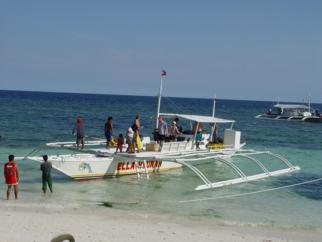

I will not describe the slave labour necessary to scrub, sand, paint and polish the outside of a 63-foot catamaran, it could put some people off 'Yachting'. All I can write is that as Gaia was hoisted high by 4 strops to a single crane wire for relaunching, gleaming in the sun she looked like a strange futurist space machine.
My delayed web letter is about our visit to the Philippines in March, to sail on the Child of the Sea / Tama Moana, our latest ethic design. Pacific double canoes have been compared in their relationship to early Pacific man as 'Spaceships of the past'. 40 hours of travel (by car, plane and ferry) from Cornwall to the Philippines seems a long way to go, to sail on such an ancient craft.

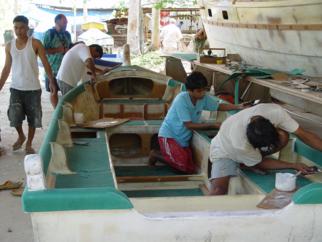
Was it worth visiting the Philippines? Yes, yes for one I am a tropic bird; warm tropic scented air is to me both exiting and relaxing. Two, the archipelago of the Philippines was a new sailing area to me. Agreed, I only saw Cebu, Bohol and its attached island of Panglao (where Andy Smith's boatyard is located), but what I did see was a vast unspoilt sailing area with warm friendly people, and beaches where people still use the traditional craft, the double outrigger Bankas. The Bankas are visually much more pleasant than looking at 'plastic fantastic yachts' which now dominate European shorelines.
The original first aim of our visit to the Philippines was to test sail the Child of the Sea, built by Andy Smith Boatworks, to write a paper about her sailing abilities for presentation at a Marine Archaeology Conference to be held in New Delhi. In the aftermath of the Tsunami this conference disappeared off the scene.
Aim 2 of the visit to the Philippines was to reorient ourselves as Pacific sailing people, with the help of Pacific friends and builders, beginning with Steve Goodman from Australia, who came with his family to join us in Panglao. I/we had not seen Rose and Steve Goodman (webmaster of this site) since they organised a major refit of Spirit of Gaia in Brisbane on our around-the-world voyage in 1997, after which they sailed with us to the Barrier Reef. We had not seen our builder Andy Smith since he last worked on the Tiki 36 as manager of our 'Wharram Built' yard in Devoran, Cornwall in the early 90s. The other two professional builders we had hoped could also meet with us in the Philippines and add their ideas to discussion, were Günter Nutt from Thailand, whom we last visited 2 years ago and Gerhard Nusser from Germany who would have liked to have come to the Philippines. Unfortunately, neither could make it.
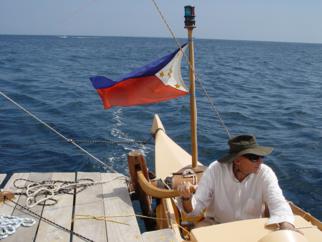
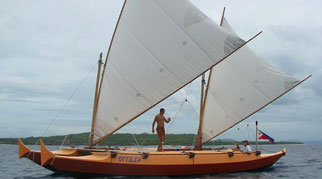
Contributing to our discussions were three Wharram owner/builders. One is Neil Sandage, an ex American pilot who went to the Philippines to build a Tiki 38, met a wonderful Philippine lady and ended up with both boat and wife.
Number two is Bjorn Wedel, German, who has built a Tiki 21, rebuilt a Pahi 31, and is now getting himself a Tiki 38, a man with extensive experience of Wharram boats.
Number three is Marcel Steinegger, Swiss, educated at an English school in South Africa (quite a mix in background), who after a deep study of multihulls on the market decided on the Child of the Sea design, built by Andy Smith.
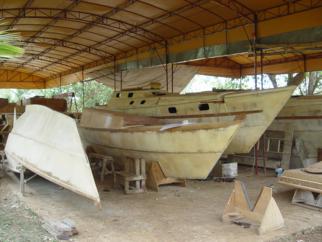
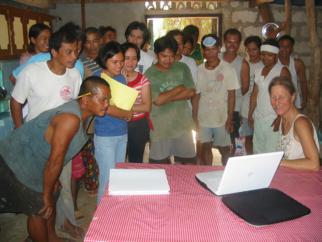
Together we discussed boat construction, paint finishes, possible export of the smaller designs in containers all over the world. Alternatively, why not leave a boat bought at SE Asian factory price in the Philippines (or Thailand) and use the money saved on shipping, RCD, Import taxes and European mooring fees, to fly out for sailing holidays in these unspoilt sailing grounds.
What kept the discussions from being dry and academic was regular sailing on Marcel's Child of the Sea and visits to Andy's boatyard and his enthusiastic workers. Andy has set up a hard working team and gives them good working conditions; with his guidance, they are producing excellent workmanship and finish. To show the exquisite 'finish' Andy's workers are producing, we were taken to see a motor catamaran that had just been launched the previous week.
Backing Andy at home is Nicola, his Philippine partner; she with house-help Linda produced daily meals for as many as 17 people, all who were discussing boats. Brave women!
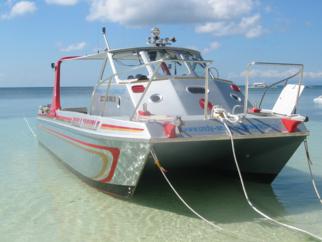
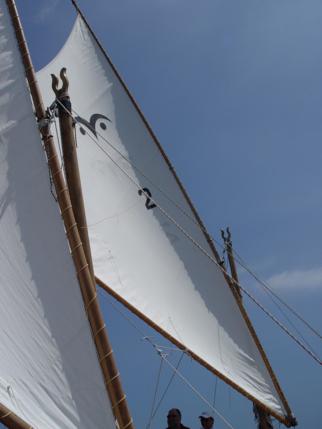
We first sighted the Child of the Sea ("Ottilia") as Marcel brought her to Alona beach with sails furled. With her shallow draft it was easy to wade out to board her. Unfortunately, during our stay we only had light winds for sailing. Marcel told us that earlier in stronger winds, he recorded speeds of 12 knots on the GPS. When sailing in rough choppy seas the bows never dipped into and under the seas. Child of the Sea builder Nr. 3, Tom Scott from Brisbane, Australia sailed with Marcel a few weeks earlier in the stronger wind conditions and they tried out many different ways of setting the Crabclaw Rig.
Light wind sailing is an important aspect of a boat's sailing ability and we spent most of our time improving sail set and sheeting by tweaking lines and adding and moving blocks. We did consider whether in winds of force 3 upwards the beautiful low drag hulls of this ancient Canoe Form would sail effectively with (lighter to handle) smaller sails. Tom Scott, who has a physical handicap, is considering trying a smaller mainsail.
The final aim is that single handed sailor Glen Tieman (builder Number 1), who inspired the Child of the Sea project, can comfortably sail her single handed across the Pacific as he did 20 years ago on a Pahi 26.
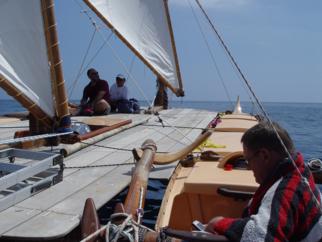
The side rudder WORKS, but the lashings holding it to the hull needed some adjusting to keep them tight. We needed only one rudder for light, effective steering.
Whilst Hanneke and Marcel trimmed the sailrig, I sat in the hull and dreamed on the minimum needed for living comfort during long distance sailing. One thing I would like is a hooped awning/bimini over the aft berth hatch. Certainly in the tropics, the boat needs more sun shelter.
Andy had been so busy boatbuilding that our visit gave him the first opportunity to sail the boat. While sitting happily in the cockpit going very red in the burning sun he phoned his yard foreman Ronie and said: "Start building a Child of the Sea for ourselves now". Next day at the yard, Ronie showed us the first cut-out ply backbone and bulkheads. The yard workers are eager to build another!
The Child of the Sea is a historic replica craft of legend; she has so much to teach us.
- James Wharram
